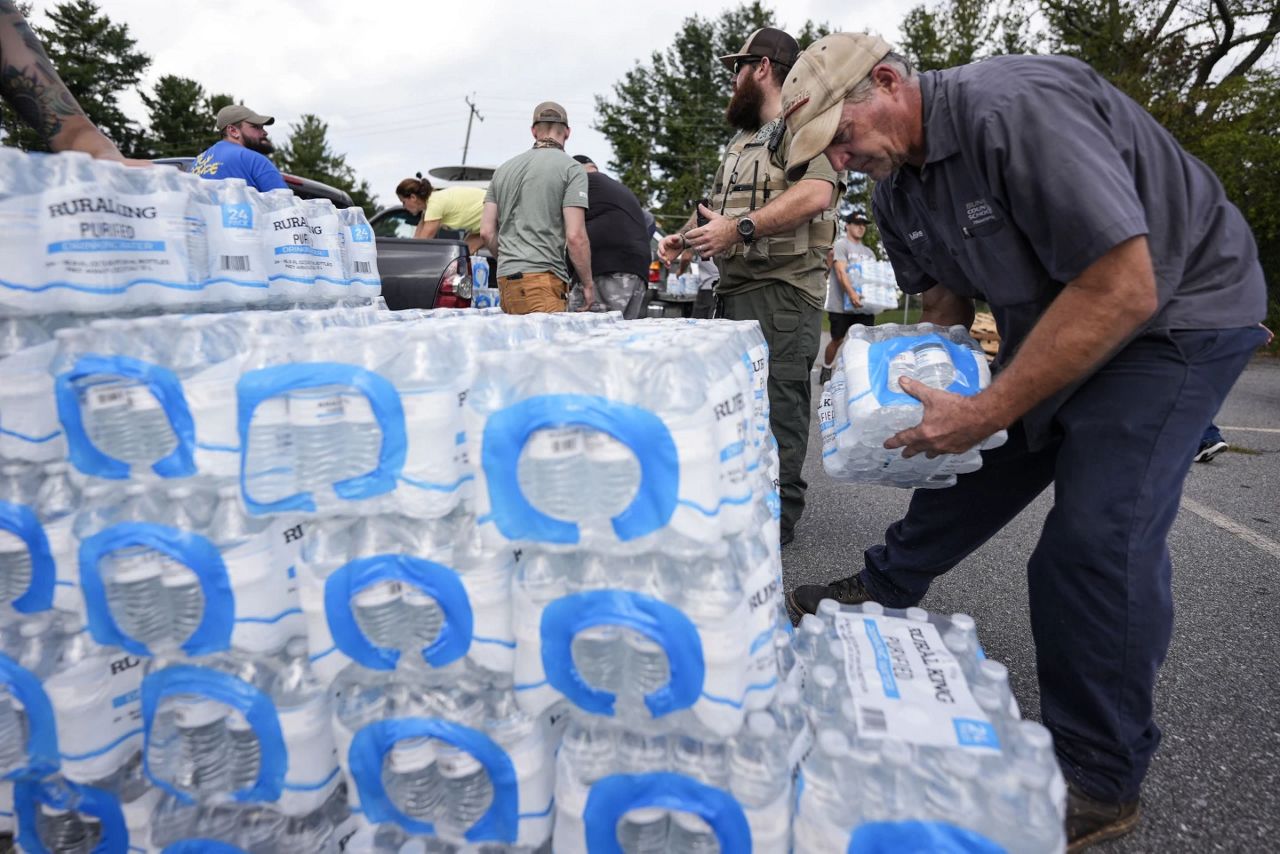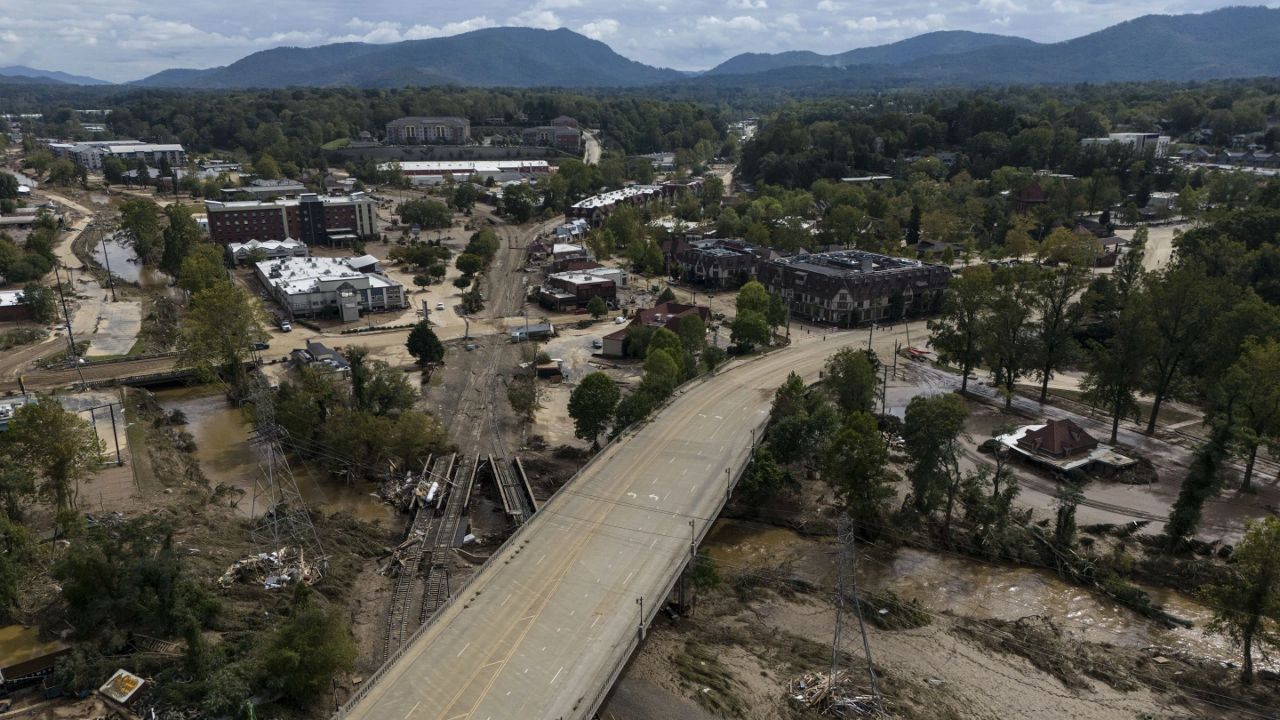ASHEVILLE, N.C. (AP) — Desperate residents of the storm-battered mountains of western North Carolina lined up for water and food, hunted for cell signals, and slogged buckets from creeks to flush toilets days after Hurricane Helene's remnants deluged the region. Exhausted emergency workers toiled around the clock to clear roads, restore power and phone service, and reach people stranded by the storm, which killed at least 133 people across the Southeast, a toll expected to rise.
And election officials across the South made emergency preparations to ensure displaced residents would be able to vote in the upcoming presidential election.
President Joe Biden was set to survey the devastation in the region Wednesday. Officials in the hard-hit tourism hub of Asheville said their water system suffered "catastrophic" damage that could take weeks to fully repair. Government officials, aid groups and volunteers worked to deliver supplies by air, truck and even mule to the town and surrounding mountain communities. At least 40 people died in Buncombe County, which includes Asheville, a normally bustling city of 94,000.
RELATED: Helene updates: 'Significant reports of storm-related fatalities' in western N.C.
The North Carolina death toll included one horrific story after another of people who were trapped by floodwaters in their homes and vehicles or were killed by falling trees. A courthouse security officer died after being submerged inside his truck. A couple and a 6-year-old boy waiting to be rescued on a rooftop drowned when part of their home collapsed.
Rescuers did manage to save dozens, including an infant and two others stuck on the top of a car in Atlanta. More than 50 hospital patients and staff in Tennessee were plucked by helicopter from the hospital rooftop in a daring rescue operation.
How some of the worst-hit areas are coping
The storm unleashed the worst flooding in a century in North Carolina. Rainfall estimates in some areas topped more than 2 feet (61 centimeters) since Wednesday, and several main routes into Asheville were washed away or blocked by mudslides. That includes a 4-mile (6.4-kilometer) section of Interstate 40 that was heavily damaged.
RELATED: Interstate 40 East, cut off for days, reopens to evacuate Asheville area, officials say
Joey Hopkins, North Carolina's secretary of transportation, asked people to stay off the roads.
"The damage is severe, and we're continuing to tell folks if you don't have a reason to be in North Carolina, do not travel on the roads of western North Carolina," Hopkins said at a news conference. "We do not want you here if you don't live here and you're not helping with the storm."

At an Ingles grocery store in Asheville, Elizabeth Teall-Fleming stood in line with dozens of others waiting to get inside and hoped to find nonperishable food, since they have no power. She planned to heat up canned food over a camp stove for her family.
"I'm just glad that they're open and that they're able to let us in," she said.
Teall-Fleming said she was surprised by the ferocity of the storm: "Just seeing the little bit of news that we've been able to see has been shocking and really sad."
In one neighborhood, residents collected creek water in buckets to flush toilets. Others waited in a line for more than a block at Mountain Valley Water to fill up milk jugs and whatever other containers they could find with drinking water.
Derek Farmer, who brought three gallon-size apple juice containers, said he had been prepared for the storm but now was nervous after three days without water. "I just didn't know how bad it was going to be," Farmer said.
Helene blew ashore in northern Florida late Thursday as a Category 4 hurricane and quickly moved north. The storm upended life throughout the Southeast, where deaths were also reported in Florida, Georgia, South Carolina, Tennessee and Virginia. Officials warned rebuilding would be long and difficult.
Federal Emergency Management Agency officials said shelters housed more than 1,000 people.
North Carolina Gov. Roy Cooper took an aerial tour of the Asheville area and later met with workers distributing meals.
"This has been an unprecedented storm that has hit western North Carolina," he said. "It's requiring an unprecedented response."
Worries about the presidential election
Karen Brinson Bell, executive director of the North Carolina State Board of Elections, said during an emergency board meeting Monday it was looking at options for voters in the hardest-hit counties. She planned to provide more information at a Tuesday news conference, including how someone could declare "natural disaster" as their reason for not being able to provide a photo ID.
Election employees across Georgia returned to work even as some offices faced power outages, limited internet and infrastructure damages.
In Lowndes County, staff at the board of elections worked on two computers instead of the usual eight, said election supervisor Deb Cox. The office is also without Wi-Fi.
"We're fully up and running as of this morning," Cox said. "It's just slower than normal because we have less resources."
In Columbia County, poll worker training will still begin this week, said Nancy Gay, the elections director, but she might have to change the location because of the power outage.
"Our poll workers are being affected," Gay said. "They don't have power. They don't have gas. You've got to allow the workers time to process everything and try and get a plan in place before I can really expect them to come and show up for training."
Mark Ard, of the Florida Secretary of State's office, said the division of elections recommends that local elections supervisors reach out to postal officials to discuss a mitigation plan for ballot mailing, delivery and return.
Why western North Carolina was hit so hard
Western North Carolina suffered relatively more devastation because that's where the remnants of Helene encountered the higher elevations and cooler air of the Appalachian Mountains, causing even more rain to fall.
Asheville and many surrounding mountain towns were built in valleys, leaving them especially vulnerable to devastating rain and flooding. Plus, the ground already was saturated before Helene arrived, said Christiaan Patterson, a meteorologist with the National Weather Service.
"By the time Helene came into the Carolinas, we already had that rain on top of more rain," Patterson said.
Climate change has exacerbated conditions that allow such storms to thrive, rapidly intensifying in warming waters and turning into powerful cyclones, sometimes within hours.
RELATED: A look at how much rain Helene dumped on western North Carolina
Destruction from Florida to Virginia
Along Florida's Gulf Coast, several feet of water swamped the Clearwater Marine Aquarium, forcing workers to move two manatees and sea turtles. All the animals were safe, but much of the aquarium's vital equipment was damaged or destroyed, said James Powell, the aquarium's executive director.
Georgia Gov. Brian Kemp said the storm "literally spared no one." Most people in and around Augusta, a city of about 200,000 near the South Carolina border, lacked power .
With at least 30 killed in South Carolina, Helene was the deadliest tropical cyclone to hit the state since Hurricane Hugo made landfall north of Charleston in 1989, killing 35 people.
Tropical Storm Kirk could become a major hurricane
Tropical Storm Kirk formed Monday in the eastern Atlantic Ocean. It is expected to become a hurricane Tuesday night and could become a major hurricane Thursday, the U.S. National Hurricane Center said. The storm was about 935 miles (1,505 kilometers) west of the Cabo Verde Islands with maximum sustained winds of 60 mph (95 kph). There were no coastal watches or warnings in effect, and the storm system was not a threat to land.
___
Contributing to this report were Associated Press journalists Gary D. Robertson in Asheville; John Seewer in Toledo, Ohio; Ben Finley in Norfolk, Virginia; Beatrice Dupuy in New York City; Zeke Miller and Aamer Madhani in Washington; and Jeff Amy in Atlanta.



